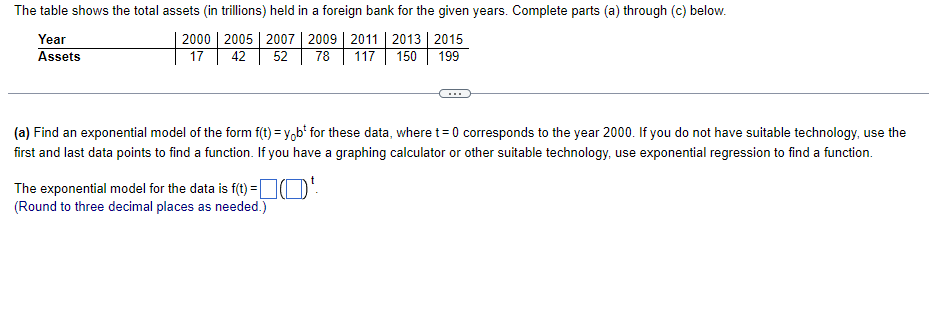The table shows the total assets (in trillions) held in a foreign bank for the given years. Complete parts (a) through (c) below. 2000 | 2005 | 2007 | 2009 | 2011 | 2013 | 2015 199 150 Year Assets 17 42 52 78 117 a) Find an exponential model of the form f(t) = y,b° for these data, where t= 0 corresponds to the year 2000. If you do not have suitable technology, u irst and last data points to find a function. If you have a graphing calculator or other suitable technology, use exponential regression to find a function The exponential model for the data is f(t) = IO' Round to three decimal places as needed.)
The table shows the total assets (in trillions) held in a foreign bank for the given years. Complete parts (a) through (c) below. 2000 | 2005 | 2007 | 2009 | 2011 | 2013 | 2015 199 150 Year Assets 17 42 52 78 117 a) Find an exponential model of the form f(t) = y,b° for these data, where t= 0 corresponds to the year 2000. If you do not have suitable technology, u irst and last data points to find a function. If you have a graphing calculator or other suitable technology, use exponential regression to find a function The exponential model for the data is f(t) = IO' Round to three decimal places as needed.)
Linear Algebra: A Modern Introduction
4th Edition
ISBN:9781285463247
Author:David Poole
Publisher:David Poole
Chapter7: Distance And Approximation
Section7.3: Least Squares Approximation
Problem 33EQ
Related questions
Question

Transcribed Image Text:The table shows the total assets (in trillions) held in a foreign bank for the given years. Complete parts (a) through (c) below.
2000 | 2005 | 2007 | 2009 | 2011 | 2013 | 2015
78
Year
Assets
17
42
52
117
150
199
(a) Find an exponential model of the form f(t) = y,b' for these data, where t= 0 corresponds to the year 2000. If you do not have suitable technology, use the
first and last data points to find a function. If you have a graphing calculator or other suitable technology, use exponential regression to find a function.
The exponential model for the data is f(t) =I0'
(Round to three decimal places as needed.)
Expert Solution
This question has been solved!
Explore an expertly crafted, step-by-step solution for a thorough understanding of key concepts.
This is a popular solution!
Trending now
This is a popular solution!
Step by step
Solved in 2 steps with 1 images

Recommended textbooks for you

Linear Algebra: A Modern Introduction
Algebra
ISBN:
9781285463247
Author:
David Poole
Publisher:
Cengage Learning


Algebra & Trigonometry with Analytic Geometry
Algebra
ISBN:
9781133382119
Author:
Swokowski
Publisher:
Cengage

Linear Algebra: A Modern Introduction
Algebra
ISBN:
9781285463247
Author:
David Poole
Publisher:
Cengage Learning


Algebra & Trigonometry with Analytic Geometry
Algebra
ISBN:
9781133382119
Author:
Swokowski
Publisher:
Cengage